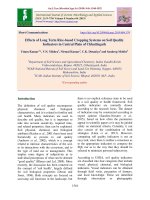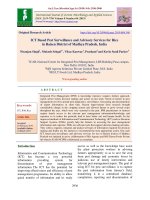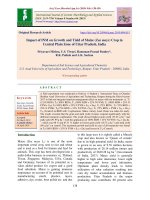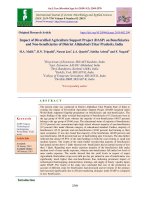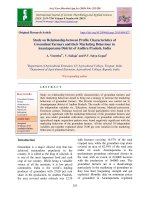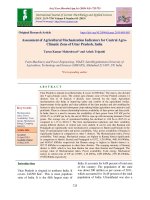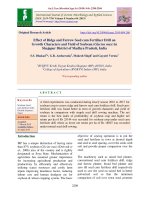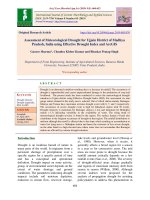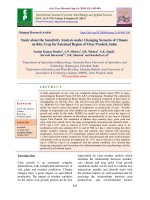Analysis of knowledge and adoption of rice cultivators trained by KVKs in central plain zone of Uttar Pradesh, India
Bạn đang xem bản rút gọn của tài liệu. Xem và tải ngay bản đầy đủ của tài liệu tại đây (238.38 KB, 6 trang )
Int.J.Curr.Microbiol.App.Sci (2020) 9(5): 1076-1081
International Journal of Current Microbiology and Applied Sciences
ISSN: 2319-7706 Volume 9 Number 5 (2020)
Journal homepage:
Original Research Article
/>
Analysis of Knowledge and Adoption of Rice Cultivators Trained by KVKs
in Central Plain Zone of Uttar Pradesh, India
Sunil Kumar1, H. C. Singh2, Arun Kumar Rajbhar3*,
Ramratan Singh1 and Ramvinay Pal1
1
2
C.S. Azad University of Agriculture & Technology, Kanpur (U P) India
Faculty of Agril. Engg. and Technology (CSAUA&T, Kanpur), Campus –Etawah, U.P., India
3School of Agriculture, Lovely Professional University, Jalandhar, Punjab, India
*Corresponding author
ABSTRACT
Keywords
knowledge,
adoption, rice
cultivator, KVKs
Article Info
Accepted:
10 April 2020
Available Online:
10 May 2020
Rice is one of the most important food crops of India. Major share of rice is cultivated
during Kharif season. The KVK is innovative institution for disseminating new
agricultural technologies and imparting many short days and long days vocational training
programmes to rural youth and farmers. The farmers trained at KVK become more alert
and fully aware citizen of the community. The KVK provides strong training support for
training significant breakthrough in agricultural production. Keeping in view the above
facts the study entitled as such given above. The study carried out in Kanpur Dehat and
Lucknow districts in Central Uttar Pradesh. The data were collected through pretested
interview schedule from randomly selected 160 trained and 160 untrained farmers. The
data were analysed for logical conclusion. The trained respondents were having higher
knowledge about improved rice cultivation technologies and high level of adoption in
respect of HYV, seed rate, sowing time and sowing method, fertilizer application and plant
protection measures of rice crop than untrained respondents. Investment pattern of trained
respondents was more as compared to untrained respondents. The availability of input like
seed, fertilizer, and plant protection measures enhanced the productivity and the
employment in rice crop on farmers’ field.
Introduction
The system of transfer of technology has
played a crucial role in modernizing
agriculture. Rice is one of the most important
food crops of India. Major share of rice is
cultivated during Kharif season. A small share
of rice is grown in rabi /summer season with
assured irrigation. In Indian, rice production
largely depends on monsoon rains and only
60.10 per cent rice area has assured irrigation
(Agricoop, 2017). In Uttar Pradesh, about
5.65 million hectare area with 12.95 million
tonne production and 2295 kg/ha productivity
and irrigated area 86.70% are under rice
cultivation.
1076
Int.J.Curr.Microbiol.App.Sci (2020) 9(5): 1076-1081
According to FAOSTAT (2016), the global
rice industry produces 738.18 million tonnes
of rice with 162.32 mha area and 4548 kg ha-1
yield in the year 2015. Asia region alone
contributes over 90% with China and India
contributing 29.3% and 17.9% shares of the
total global output, respectively. Krishi
Vigyan Kendra (KVK) is an innovative
science based institution which under takes
vocational training of farmers, farm women
and rural youth, conducts on farm research for
technology
refinement
and
frontline
demonstrations to promptly demonstrate the
latest agricultural technologies to the farmers
as well as the extension worker. The KVK
function on the principles of collaborative
participation of scientists, subject matter
specialist, extension worker and farmers. The
government of India has set a target of
expanding the cultivation of rice with hybrid
seed.
Current growth trends suggest that this target
will not be met, despite the potential
contribution of hybrid rice to lagging growth
in national rice yields, overall rice production,
land-use reallocation and food security. KVK
is based on the recommendations of the
education commission (1964-66) and interministerial committee (1973), ICAR (Indian
Council of Agricultural Research) decided to
establish KVKs in the country. A high level
committee headed by Dr. Mohan Singh Mehta
recommended the establishment of KVK to
provide skill oriented vocational training
support for farmers. Rice is grown under so
diverse soil and climatic conditions that it is
said that there is hardly any type of soil in
which it can be grown including alkaline and
acidic soils. Rice crop has also got wide
physical adaptability.
Materials and Methods
The present study was conducted in Central
plain zone of Uttar Pradesh to evaluate the
knowledge and adoption on rice cultivation.
The KVK provides strong training support for
training to significant breakthrough in
agricultural production. Keeping in view the
above facts, the study entitled as such given
above. The study carried out in Kanpur Dehat
and Lucknow districts in Central Uttar
Pradesh. The data were collected through
pretested interview schedule from randomly
selected 160 trained and 160 untrained
farmers. The data were analysed for logical
conclusion by using statistical tools like
percentage, frequency, mean and t- test.
Results and Discussion
Knowledge
Knowledge is defined as the set of concepts,
meanings, skills and routines development
over time by individual and groups through
processing of information. Once the
knowledge is acquired, it also brings about
changes in overt behaviour such as adoption.
In the present study it was hypothesized that
the extension activities of KVK such as on
farm trial, farm and home visits, method and
result demonstrations, trainings and field days
would lead to an increase in knowledge of the
respondents regarding the technological
intervention.
The table 1 depicts that the mean score
pertaining to knowledge of trained and
untrained
respondents
regarding
the
technological intervention on rice were 50.90
and 43.19, respectively. The difference
between mean scores was 7.71. The value of
‘t’ ratio is 19.72 which is significant at 0.01
level of probability. This indicates that the
respondents from trained category possessed
significantly higher level of knowledge about
improved rice cultivation technologies than
the untrained respondents to improved rice
cultivation technologies through various
activities of KVKs.
1077
Int.J.Curr.Microbiol.App.Sci (2020) 9(5): 1076-1081
The respondents from trained category also
possessed significantly higher level of
knowledge about improved rice cultivation
technologies. It may therefore be concluded
that the various extension activities of KVKs
helped in improving the knowledge level of
the farmers regarding improved rice
cultivation technologies.
It is evident from table 2 that majority 67.5%
of the respondents from trained category had
medium extent of knowledge; while 20% had
high extent of knowledge, and 12.5% had low
extent of knowledge. In untrained category
the majority 76.875% respondents had
medium extent of knowledge, while 18.125%
were having low extent of knowledge and
only 5% having high extent of knowledge.
The respondents from trained category also
showed higher extent of knowledge
This
could be due to the exposure of the trained
farmers to knowledge through on-farm trials
conducted under KVKs. The untrained
farmers lacked this opportunity and hence,
they showed lower extent of knowledge of
these technologies.
Adoption
The adoption is the function of an individual
respondent. KVKs have made many efforts to
provide trainings and required inputs to the
respondents for more production, some of the
respondents were doing well while others
adoptions of the practices were on an average
or at lower level. To record the level of
adoption of each individual, we put them in
various adoption levels.
It is evident from table 3 that out of 160
trained respondents, the 129(80.625%) were
under high adoption category, 22(13.75%)
medium adoption category and 18(11.02%)
low adoption category. None was under no
adoption category of adoption in case of high
yielding varieties. For seed rate, sowing time
and method of sowing 115(71.875%)
respondents were high adopter and remaining
47(29.375%) and 13(8.125%) were medium
adopter and low adopter, respectively. With
regard to fertilizer application, 110(68.75%)
were under high adopter category,
41(25.3625%) medium, 12(7.5%) low and
4(2.5%) were found non-adopter category.
For plant protection measures, maximum
50(31.25%) were found under non adopters
category 40(25%) low, 45(28.125%) medium
and 32(20%) were found under high adopters
category.
The overall scenario of this table indicates
that except in plant protection, majority of the
trained respondents were in high adoption
category followed by medium adoption in
respect of high yielding varieties, seed rate,
sowing time and method of sowing, &
fertilizer application in rice crop. With regard
to plant protection, the scenario with different
as the majority of farmers were under nonadopter category followed by low, medium
and high. This was due to high cost and
unawareness about the plant protection
chemical and its equipments. This is also due
to non-seriousness of the cultivators.
It is clear from the above table 4 that out of
160 untrained respondents 102(63.75) were
under high adoption category, 55(34.38%)
medium adoption category and 25(15.63%)
low adoption category. Only 5(3.15%) were
under no adoption category in HYV. For seed
rate, sowing time, sowing method 81(50.63%)
were of higher adoption category followed by
medium adoption category, 28(17.5%) low
adoption category and remaining 6(3.75%)
under no adoption category.
For fertilizer application 75(46.88%) were
under medium adopter category followed by
63(39.38%) high adoption, 32(20%) low
adoption and 09(5.63%) under no adoption
1078
Int.J.Curr.Microbiol.App.Sci (2020) 9(5): 1076-1081
category. In case of plant protection measures
90 (56.25%) were found in no-adoption
category followed by 33 (20.63%) under low
adoption category and 31 (19.38%) under
medium adoption category in plant protection
measures. The overall picture of this table
depicts that except in plant protection,
majority of untrained respondents were in
high adoption category followed by medium
and low in the practices mentioned above.
When we look for plant protection measures,
the situation is just reverse because majority
of the untrained respondents were under no
adoption category and almost negligible
number of respondents adoption same. This
was due to higher cost involved in purchasing
chemical and equipment and unawareness
about the plant protection measures.
Table.1 Difference in knowledge about improved rice cultivation technologies between the
trained and untrained respondents
Sl.No.
Respondents
Trained
Untrained
1.
2.
Mean
(Score)
50.90
43.19
Difference
In mean
7.71
‘ ’
t value of
mean
19.72**
** Significant at 0.01 level of probability, d f =318
Table.2 Distribution of the respondents according to their extent of knowledge about improved
rice cultivation technologies (N=160)
Sl.No.
1.
2.
3.
Categories
Frequency
Trained
20(12.50)
108(67.50)
32(20.00)
160(100)
Low
Medium
High
Total
Untrained
23(18.13)
123(76.88)
08(05.00)
160(100)
*Figures in parenthesis indicate percentages.
Mean= 73.06, SD = 1.44, (Trained), Mean = 61.71, SD = 7.35(Untrained)
Table.3 Level of adoption of the trained respondents in relation to selected
package of practices of rice
Sl.
No.
Level of
adoption
Class range
HYV
1.
No
adoption
Low
adoption
Medium
adoption
High
adoption
00.00-00.00
_
Seed rate,
Sowing time
and sowing
method
_
0.01-30.00
18
(11.02)
22
(13.75)
129
(80.63)
13
(8.125)
47
(29.38)
115
(71.88)
2.
3.
4.
30.01-60.00
Above 60.00
*Figures in parenthesis indicate percentages
1079
Fertilizer
Appt.
Plant
protection
measures
04
(2.50)
12
(7.50)
41
(25.63)
110
(68.75)
50
(31.25)
40
(25.00)
45
(28.13)
32
(20.00)
Int.J.Curr.Microbiol.App.Sci (2020) 9(5): 1076-1081
Table.4 Level of adoption of the untrained respondents relation to selected
package of practices of rice
Sl. No.
Level of
adoption
Class range
HYV
1.
No
adoption
Low
adoption
Medium
adoption
High
adoption
00.00-0.00
05
(03.15)
25
(15.63)
55
(34.38)
102
(63.75)
2.
3.
4.
0.01-30.00
30.01-60.00
> 60.00
Seed rate,
Sowing time and
sowing method
06
(03.75)
28
(17.50)
62
(38.75)
81
(50.63)
Fertilizer
Application
09
(05.63)
32
(20.00)
75
(46.88)
63
(39.38)
Plant
protection
measures
90
(56.25)
33
(20.63)
31
(19.38)
-
*Figures in parenthesis indicate percentages
The trained farmers have higher knowledge
about improved rice cultivation technologies
and high level of adoption of HYV, seed rate,
sowing time and sowing method, fertilizer
application and plant protection measures of
rice crop than untrained respondents.
Knowledge and adoption about improved rice
cultivation technologies by both trained and
untrained respondents were found to be
positively and significantly related to their
education, occupation, size of family, size of
land holding, annual income, material
possession, social participation, management
orientation and communication behavior,
While age variable was positively correlated
to knowledge and negatively correlated to
adoption variable.
References
Agricoop (2017). Total rice area, production
and productivity in India. Directorate of
Economics and Statistics.
Babu, R. P and Sivanarayana, G. 2016.
Constraints faced by the rice farmers
in adoption of
recommended technologies in
East
Godavari district of Andhra Pradesh.
Journal of Research ANGRAU. 44(1/2):
83-87.
Bhakthavatsalam, K. V. S.; Mundinamani, S.
M.; Rani, and D. J. Gayathri Mohan
2015. A comparative study on On-Farm
Demonstration (OFD) to farmers fields
for paddy cultivation in Dharwad
district of Karnataka state. International
Research Journal of Agricultural
Economics and Statistics. 6(2): 342348.
Borthakur S; Mishra P; Talukdar R. K. and
Bortamuly D. 2015. Scaling the
Adoption of Recommended Rice
Production Technologies by the
Farmers in Assam State. Indian Res. J.
Ext. Edu. 15(2): 30-35.
Chandawat, M. S; Bhimawat, B. B. S. and
Jaitawat, G. S. 2004. Farmers opinion
about KVK training. Indian Research
Journal of Extension Education.
4(1&2): 97-101.
FAO (2016). World agricultural statistics on
rice production, area and productivity.
Gopal, P. V. S; Sreedevi, K. and Prasad, S. V.
2014. Constraints analysis of integrated
pest management (IPM) in rice and the
strategies to overcome the constraints.
Current Biotica. 7(4): 306-313
Rayuda, B.T; Leena, S; Kumar, V; Krishna,
Degde and Saritha .2003. Effectiveness
of training knowledge level of farmers
about Vanilla cultivation. Agricultural
Extension Review. 15(5): 14-21.
1080
Int.J.Curr.Microbiol.App.Sci (2020) 9(5): 1076-1081
How to cite this article:
Sunil Kumar, H. C. Singh, Arun Kumar Rajbhar, Ramratan Singh and Ramvinay Pal. 2020.
Analysis of Knowledge and Adoption of Rice Cultivators Trained by KVKs in Central Plain
Zone of Uttar Pradesh, India. Int.J.Curr.Microbiol.App.Sci. 9(05): 1076-1081.
doi: />
1081
